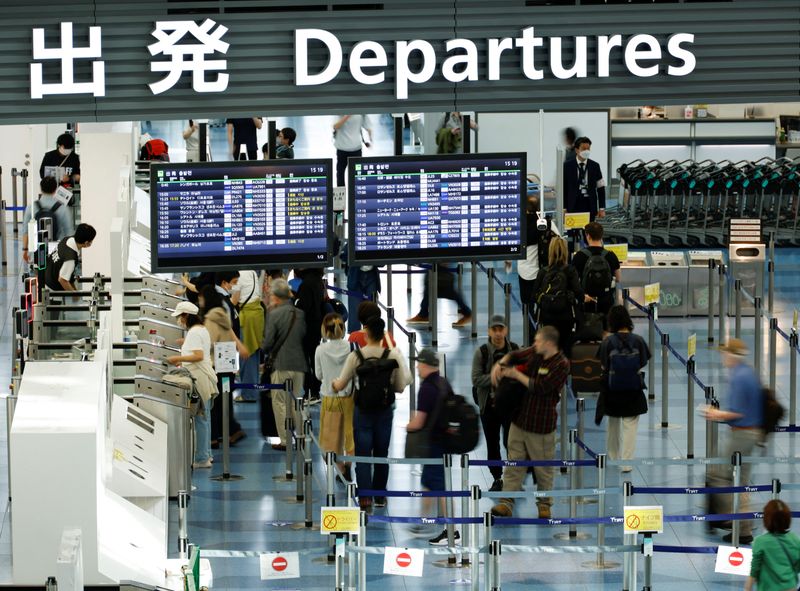Analysis – Airfares hit peaks in Europe, Asia as travelers seek to cut costs By Reuters

Written by Joanna Plucinska, Lisa Barrington, Rajesh Kumar Singh
LONDON/SEOUL/CHICAGO (Reuters) – Airfares in Europe and Asia have stagnated or begun to fall in a sign that the long post-COVID-19 travel boom is waning, creating a challenge for airlines struggling with high costs and limited aircraft availability. are experiencing.
As air travel opens up after the pandemic, the global imbalance between flight supply and pent-up demand has driven up ticket prices and passenger yields – a measure of the average fare each passenger pays per mile.
But industry executives, investors and analysts say the “travel at all costs” trend is being balanced, with some customers becoming more price sensitive due to inflation driving up the cost of living.
Michael O’Leary, the CEO of budget airline Ryanair, warned that ticket prices will rise less than expected this month, sending shares of the European airline lower.
“It’s somewhat surprising that prices aren’t stronger and I’m not sure if this is just consumer sentiment or the feeling of a recession across Europe,” O’Leary said.
Rates were flat globally in the first months of the year compared to 2023, according to data from travel research group ForwardKeys.
The picture is even starker in Asia Pacific, where freight rates fell the most from January to April, down about 16% year-on-year, according to the data.
Last week, Singapore Airlines (OTC:) reported record annual profits, but net profit growth has declined over the past three quarters. The benchmark Asian carrier said it expects passenger yields to ease further as airlines expand capacity.
Asia has been slower than other regions to lift restrictions and increase flights to international destinations.
“We believe supply and demand will rebalance themselves and airfares will continue to normalize throughout 2024,” Ronald Lam, CEO of Hong Kong-based Cathay Pacific, said in March.
Travel from China to markets such as Europe, the US and Australia has not recovered. China’s economy is weak and international flights remain at about 70% of pre-pandemic levels. For US-China routes, it is only 16.5%.
Flight Center Travel Group said international airfares sold in Australia fell 12.8 per cent in the first three months of the year compared to the same period last year.
Nonetheless, prices in Asia Pacific are up more than 7% compared to 2019, and 2021 freight rates are 70% higher than in 2019.
price sensitivity
Economists and investors are not yet pessimistic. Travel remains a spending priority for most consumers, especially in Europe and the United States, economists said.
But economists and analysts say cheaper European airfares will lower income and savings rates across the continent, forcing consumers to look for cheaper options, especially as hotels and car rentals become more expensive.
“Consumers are still interested in travel, but European consumers in particular are very price sensitive,” said Natalia Lechmanova of Mastercard (NYSE:).
She said affordable destinations such as Turkey, Romania and the Balkans are surging in popularity among European travelers looking for alternatives to France or Italy.
European consumers are expected to spend 742.8 billion euros ($803 billion) this year, up 14.3% from last year, according to data from the European Travel Commission. But this could be largely driven by wealthy American tourists, industry experts said.
travel to usa
U.S. consumer spending remains steady as Europeans look to save, and demand is particularly strong for premium travel.
About 16 million Americans traveled abroad in the first quarter of 2024, setting a new record and surpassing pre-pandemic levels, according to the Mastercard Economics Institute.
Economists said America’s strong labor market is helping consumers keep spending higher despite falling household savings.
Average travel spending per U.S. household fell just 1.5% year over year in the first five months of the year, but was 13% higher than in 2019, according to Bank of America credit and debit card data.
Global airline executives say consumers still want to spend money on travel and prioritize experiences over products.
“This is a very cyclical industry and it’s also very sensitive to macroeconomics,” said Jamie Lindsay (NYSE:), an aviation investor at Artemis Funds.
But he does not expect the decline in Europe and Asia to lead to a broader sector downturn.

“It’s not that rates are falling (everywhere). It’s more of a normalization.”
($1 = 0.9246 euros)


